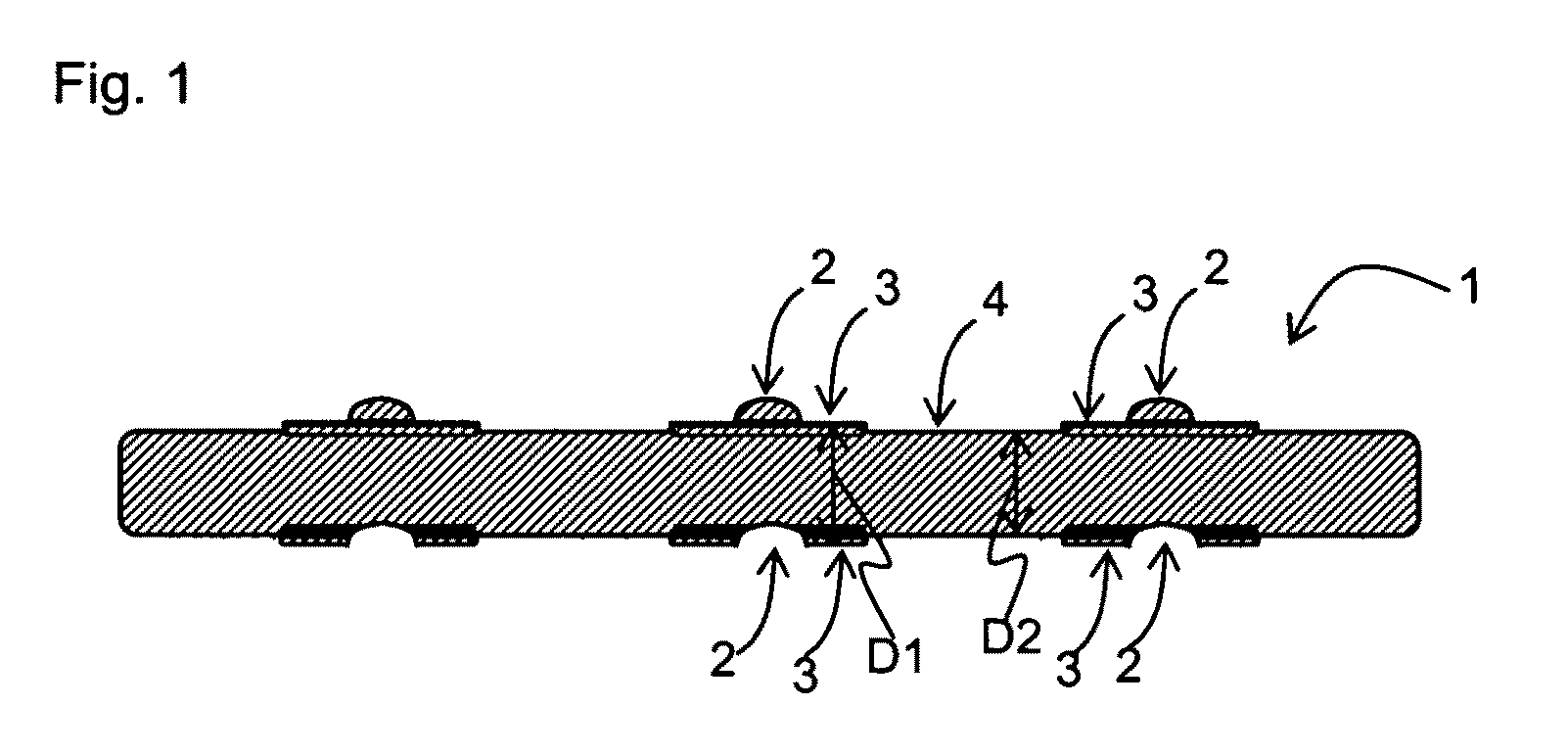Optical element wafer and method for manufacturing optical element wafer, optical element, optical element module, electronic element wafer module, electronic element module, and electronic information device
- Summary
- Abstract
- Description
- Claims
- Application Information
AI Technical Summary
Benefits of technology
Problems solved by technology
Method used
Image
Examples
embodiment 1
[0105]FIG. 1 is an essential part longitudinal cross sectional view illustrating an exemplary structure of a lens wafer according to Embodiment 1 of the present invention.
[0106]In FIG. 1, in a lens wafer 1 functioning as an optical element wafer of Embodiment 1, a plurality of lens areas 2 are formed as a plurality of optical element areas on either a front surface or a back surface thereof. A planarized portion 3 is disposed with a predetermined thickness on the outer circumference side of the lens area 2. A thickness D1 of the planarized portion 3 between adjacent lens areas 2 and a thickness D2 of a connecting portion 4 between the planarized portions 3 are within the ratio of 2:1 (2 / 1 or 1 / 2) to an equal ratio. Preferably, the thickness D1 of the planarized portion 3 between adjacent lens areas 2 is within the ratio of 4 / 3 (or 3 / 4) to an equal ratio with the thickness D2 of the connecting portion 4 between the planarized portions 3.
[0107]Herein, the resin thickness D2 between in...
embodiment 2
[0122]In Embodiment 2, a variation of a lens as an optical element, which is individualized from the lens wafer 1 as an optical element wafer formed by the upper and lower stamper molds 15 and 16 in Embodiment 1, will be described in detail. Furthermore, a variation of a lens module as an optical element module, in which the plurality of lenses are laminated, will be described in detail.
[0123]FIG. 6(a) is a longitudinal cross sectional view illustrating an exemplary variation of a lens individualized from the lens wafer of FIG. 1. FIG. 6(b) is a longitudinal cross sectional view illustrating an exemplary lens module in which a plurality of lenses are laminated. FIG. 6(c) is a top view of the second lens of FIG. 6(b). FIG. 6(d) is a top view of the first lens of FIG. 6(b). FIG. 6(e) is a longitudinal cross sectional view of a combination of the first lens and a light shielding holder. FIG. 6(f) is a longitudinal cross sectional view of a lens module of a combination of the exemplary ...
embodiment 3
[0132]FIG. 7 is a longitudinal cross sectional view illustrating an exemplary essential part structure of a sensor module according to Embodiment 3 of the present invention.
[0133]In FIG. 7, a sensor module 10 as an electronic element module according to Embodiment 3 includes: an image capturing element 21, which includes a plurality of light receiving sections for performing photoelectric conversion on and capturing an image of image light from a subject, disposed at the center portion; an image capturing element chip 20 with a penetrating electrode 22 to the image capturing element 21; a resin adhesion layer 30 formed on the image capturing element chip 20 and between adjacent image capturing elements 21; a transparent support substrate 40, such as a glass plate, covering the image capturing element chip 20 and adhered and fixed on the resin adhesion layer 30; a lens module 50 provided to correspond to the image capturing element 21.
[0134]With regard to the image capturing element ...
PUM
 Login to View More
Login to View More Abstract
Description
Claims
Application Information
 Login to View More
Login to View More - R&D
- Intellectual Property
- Life Sciences
- Materials
- Tech Scout
- Unparalleled Data Quality
- Higher Quality Content
- 60% Fewer Hallucinations
Browse by: Latest US Patents, China's latest patents, Technical Efficacy Thesaurus, Application Domain, Technology Topic, Popular Technical Reports.
© 2025 PatSnap. All rights reserved.Legal|Privacy policy|Modern Slavery Act Transparency Statement|Sitemap|About US| Contact US: help@patsnap.com



